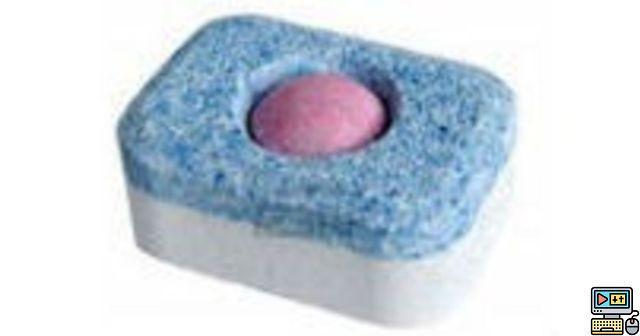 Comment (45)
Comment (45)
The number of products marketed for dishwashers is impressive: salts, powders, liquids and... all-in-one tablets. Are these sufficient for proper operation or do you need to add rinse aid and salts? Pierre-Antoine Mulot, dishwasher product manager at Whirlpool, shed some light.
TechnologiesTips: in a dishwasher, if you use all-in-one tablets, should you add other products to obtain an optimal result and limit washing marks? Is it the same for devices that offer a program dedicated to these tablets?
Pierre-Antoine Mulot: Today there are three types of detergents: tablets or tablets, powders and liquids. The consumer can choose the one he prefers because these three formulas give good results, provided they do not forget an essential step when using the dishwasher for the first time. It consists of determining the degree of hardness of the water, which must be set regardless of the detergent used. To wash the dishes at best, you need soft water, which is why a water softener is integrated into all the appliances in the form of a resin pot; very hard water (high in limestone) consumes a lot more regenerating salt because it prevents the limestone from reaching the dishwasher (it remains contained in the resin pot). Very hard water therefore requires a lot of salt. All-in-one tablets are convenient because everything is contained in a small tablet, but these are not necessarily the right doses for hard, medium hard or soft water. With very hard water, you will still need to add salt and adjust the water hardness level.
Water hardness in Spanish counties.
To determine and adjust the level of hardness (this is the case with Whirlpool and no doubt with competitors), we have agreements with detergents (Sun for Whirlpool) which include a dishwasher user guide and a tab to pass under tap water; its color makes it possible to determine the level of hardness. This step is too often neglected but nevertheless vital to avoid scale deposits in the appliance and to obtain optimal drying quality.
In a tablet, the rinsing liquid is present in limited quantity. Depending on the hardness level of the water, more may be needed. As a consumer, certain elements make it possible to determine this. If you notice the presence of white marks, produced by limestone, generally on the glasses, you must increase the level of adjustment of the water hardness. And if traces are rather present on the plates but come off easily, or if the dishes are not dry at the end of the cycle, we can assume that there is rather a lack of rinse aid.
Even using all-in-one tablets, these shortcomings can be "filled" by adding something else?
Absolutely. If you use all-in-one tablets without having made the adjustments first, you will not have any problem if the water is very soft. On the other hand, if the water is average or hard, it will be necessary to fill the salt pot and the rinse aid reservoir. Even if the tablets are very practical, they do not always meet all the needs in terms of detergents and rinse aid.
Are these adjustments that can be made even if you did it wrong the first time?
Absoutely ! Nothing is irremediable. You can go back to your settings or change them at any time. As a precaution, we recommend (because we know that the instructions for use are not always read) to fill the pot with salt and the rinsing liquid, to be certain that the consumer is not disappointed with the result.
When one has a special tablet program or an option, it means that the manufacturer has developed a specific program and one will not be able to use a tablet on a fast program, because it will not have time to dissolve completely, therefore all actions will not have taken place to obtain clean and dry dishes. In addition, the dedicated programs offer a temperature rise that respects enzymatic stages. Depending on the temperatures in the tank, the enzymes play their role to wash, carry out an antibacterial rinse and then dry. Dedicated programs allow the tablet to play its role of detergent product and rinse aid to the best of its ability. Another limitation: some consumers place the tablet directly in the appliance, which becomes completely ineffective because it begins to dissolve during the prewash and the detergent is missing during the washing phase. It is therefore very important to put the tablets in the detergent drawer and not in the cutlery drawer, for example.
There are 3-in-1, 4-in-1 and even 5-in-1 tablets; how to choose ? If I choose 3-in-1, will I miss something?
The bare minimum is 3-in-1. These tablets contain the detergent product, a rinse aid and salt substitutes, the three elements necessary for a complete action of the dishwasher: the salt softens the water, the detergent has washing properties and the rinse aid allows drops of water glide better on the dishes so that they dry quickly and without streaks.
The 4-in-1 or 5-in-1 tablets are equipped with additional constituents, for example to protect the glass, to shine certain steel utensils... it is not mandatory to ensure washing and drying in the dishwasher. The washing efficiency will be the same. Nothing vital then, these are options on programs or dishes washed more often in the dishwasher.
Whether we use separate products or tablets, if used well, will the effectiveness be the same?
Absolutely ! It's just a question of leaving the choice to the consumer, with a preference all the same, when the water is very hard, for the separated products, which is faster — unless there is a program specific tablet on the device.
Do you have a specific question? Put it here!


























